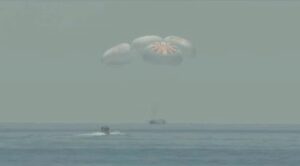Crew Dragon splashes down to end successful test flight
By Jeff Foust

WASHINGTON — SpaceX’s Crew Dragon spacecraft splashed down in the Gulf of Mexico Aug. 2, successfully completing a test flight and crossing the finish line of the decade-long commercial crew program.
The Crew Dragon, named Endeavour by its crew, splashed down about 70 kilometers south of Pensacola, Florida, at 2:48 p.m. Eastern to end the Demo-2 mission. Recovery boats were on the scene within minutes, and the spacecraft was on board the main recovery ship 30 minutes after splashdown. Astronauts Bob Behnken and Doug Hurley were in good health after splashdown, according to NASA.
The splashdown came nearly an hour after the spacecraft jettisoned its trunk section and started a deorbit burn that lasted more than 11 minutes. Preparations for the reentry went smoothly with no major issues reported.
The spacecraft, which arrived at the International Space Station May 31, a day after its launch from Florida, undocked from the station Aug. 1 at 7:35 p.m. Eastern. The spacecraft’s departure from the station went as planned, performing a series of departure burns of its thrusters to prepare for the reentry.
Crew Dragon returned to Earth the two astronauts along with about 150 kilograms of equipment, primarily science payloads being returned to researchers. The astronauts are also returning an American flag that was brought to the station on the final space shuttle mission, STS-135, in 2011. That flag, which also flew on the first shuttle mission in 1981, was brought to the ISS to be returned by the next crewed American spacecraft to visit the station, which was the Demo-2 mission.
“This flag has spent some time up here, on the order of nine years since we dropped it off on STS-135,” said Hurley, who was part of the STS-135 crew, during a departure ceremony on the station Aug. 1. “Very proud to return this flag home.”
The successful splashdown marked the conclusion of the final test of the Crew Dragon spacecraft prior to its certification by NASA for routine missions transporting astronauts to and from the station. SpaceX received a $2.6 billion contract in 2014 for the final development and testing of the spacecraft, which included an uncrewed test flight, Demo-1, in March 2019. The contract also includes up to six operational flights to the station.
With the successful end of the Demo-2 mission, those operational flights can begin, years later than originally expected when NASA started the commercial crew program in 2010 with a set of small awards to several companies. Funding shortfalls in the early years of the program, coupled with technical problems, pushed back the first flights of the spacecraft from 2015 to 2020.
Now that Demo-2 has returned safely, NASA now plans to rely on commercial vehicles for transporting astronauts to and from the station. The first operational mission, Crew-1, is scheduled for launch no earlier than late September, carrying three NASA astronauts and one from the Japanese space agency JAXA.
“It’s really establishing the business model for the future,” NASA Administrator Jim Bridenstine said in an appearance on NASA TV Aug. 2 a couple hours before splashdown. “This is the next era for spaceflight, where NASA gets to be the customer.”
Boeing, the other company developing a commercial crew vehicle for NASA, is still working on its CST-100 Starliner spacecraft. That vehicle flew an uncrewed test flight in December 2019 that was cut short by technical problems, including software issues and communications difficulties. Reviews by NASA and Boeing identified about 80 recommendations to address those problems.
Boeing hopes to perform a second uncrewed spaceflight, which the company will fund itself, no earlier than late this year. That will be followed by a crewed flight test, with two NASA astronauts and former NASA astronaut Chris Ferguson, who now works for Boeing, some time in 2021.
August 3, 2020 at 12:40AM
via SpaceNews read more...

Post a Comment